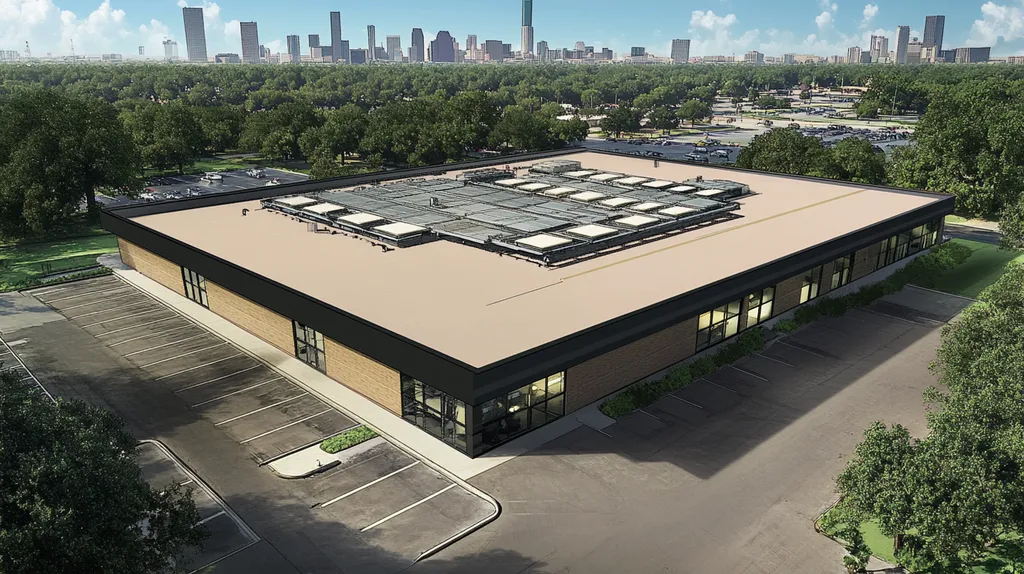Welcome to today’s Battle Royale featuring two roofing heavyweights: “Leaf Blowers” in the east corner versus “Power Washers” in the west!
Tonight’s showdown pits these contenders against each other across six punishing rounds designed to test every aspect of their performance for Commercial Roof Debris Removal.
At stake? Millions in potential costs, decades of building protection, and the critical performance demands of modern commercial and industrial facilities.
Our professional judging panel will evaluate each round on technical merit, real-world performance, and value delivery. After all six rounds, we’ll declare our ultimate champion.
Ladies and gentlemen, facility managers and building owners… it’s time to rumble!
ROUND 1: INITIAL COSTS & INSTALLATION
Ineffective debris removal threatens the structural integrity of commercial roofs, potentially leading to thousands in repair costs and premature replacement. Property managers must weigh equipment costs, setup requirements, and implementation timelines when selecting a debris removal system that aligns with their maintenance goals and budget constraints.
Material Expenses
Commercial-grade leaf blowers represent a modest initial investment, typically ranging from $200-600 for backpack models suitable for rooftop use. Fuel costs average $10-15 per day of operation, with minimal replacement parts needed annually.
Professional power washing systems demand significantly higher upfront costs, often $1,500-3,000 for units capable of safe rooftop operation. Additional expenses include specialized nozzles, chemical treatments, and water usage fees that can exceed $50 per cleaning session.
Regular maintenance costs for power washers, including pump repairs and hose replacements, typically run 2-3 times higher than leaf blower maintenance. The substantial price difference makes leaf blowers the clear choice for budget-conscious facility managers.
Installation Complexity
Leaf blowers require minimal setup time and can be safely operated after basic safety training. Their lightweight design and simple controls allow maintenance teams to begin debris removal immediately.
Leaf blowers are effective for removing lightweight materials, though proper attention must be paid to controlling where debris falls to avoid creating hazards below. Designated collection areas should be established before beginning work. (source: Simplified Safety)
Power washers demand extensive setup procedures, including water source connection, pressure testing, and chemical mixing when needed. Proper training is essential to prevent damage to roofing materials from excessive pressure or improper technique.
Given the straightforward nature of leaf blower operation versus the complexity of power washer setup, leaf blowers hold a significant ADVANTAGE in this category.
Project Timeline
Leaf blower debris removal typically requires 1-2 hours per 10,000 square feet of roof surface. Most commercial properties can be cleared in a single day, allowing for rapid response to maintenance needs.
Power washing operations progress more slowly, averaging 4-6 hours per 10,000 square feet. This timeline extends further when accounting for setup, water management, and drying time between sections.
The extended duration of power washing projects increases labor costs and extends facility disruption. Leaf blowers demonstrate clear superiority in project timeline efficiency.
ROUND 1 WINNER: LEAF BLOWERS
ROUND 2: DURABILITY & LIFESPAN
The choice between leaf blowers and power washers significantly impacts commercial roof longevity and maintenance costs. Improper debris removal methods can accelerate material degradation, leading to premature failure and expensive repairs. Understanding how these cleaning approaches affect roofing systems helps facility managers make informed decisions that protect their building investments.
Impact on Roof Materials
Different roofing materials require specific maintenance approaches to preserve their protective qualities. Single-ply membranes, modified bitumen, and built-up roofing systems each respond differently to mechanical and water-based cleaning methods.
Leaf blowers provide gentle mechanical cleaning that removes surface debris without stressing roofing materials. Their adjustable force settings allow maintenance teams to safely clear different areas without risking membrane damage.
Power washers effectively remove stubborn debris but require precise pressure control to avoid damaging roofing materials. Using incorrect settings can erode protective coatings and create points of water infiltration. (source: Steadfast Roofing FL)
Given the lower risk of material damage, leaf blowers demonstrate a clear ADVANTAGE in this category.
Long-Term Maintenance Costs
Regular debris removal plays a crucial role in preventing expensive repairs and extending roof lifespan. Equipment selection directly impacts the frequency and cost of maintenance activities.
Leaf blower maintenance programs typically require quarterly service visits, with minimal risk of causing damage that requires additional repairs. Their gentle cleaning action helps preserve protective coatings and maintain membrane integrity.
Power washing systems often necessitate more frequent maintenance due to water pooling and chemical residue concerns. The increased complexity and potential for damage can lead to higher long-term maintenance costs.
The simplified maintenance requirements and reduced repair needs give leaf blowers an ADVANTAGE in this category.
Environmental Resilience
A roof’s ability to withstand environmental stresses depends partly on how cleaning methods interact with weather conditions. Proper debris removal should enhance rather than compromise environmental resistance.
Leaf blowers allow for rapid debris removal regardless of temperature or humidity levels. Their use doesn’t introduce additional moisture that could compromise roof integrity during freeze-thaw cycles.
Power washing operations must carefully consider weather conditions, as trapped moisture can accelerate deterioration. Chemical cleaners may also interact negatively with UV exposure and temperature fluctuations.
The superior weather flexibility and reduced moisture concerns give leaf blowers an ADVANTAGE in environmental resilience.
ROUND 2 WINNER: Leaf Blowers
ROUND 3: PERFORMANCE FACTORS
Commercial roof maintenance demands consistent attention to debris removal to prevent costly structural damage. Poor debris management can lead to water pooling, membrane deterioration, and drainage system failures that compromise roof integrity. Understanding how different removal methods perform under real-world conditions helps facility managers select equipment that delivers reliable, cost-effective results.
Cleaning Efficacy
Comprehensive debris removal prevents accumulation that can trap moisture and accelerate material breakdown. Different cleaning methods must effectively address both surface debris and embedded contaminants to maintain roof performance.
Leaf blowers excel at removing loose materials like leaves, pine needles, and light sediment. Their adjustable airflow allows operators to clear debris without damaging sensitive roofing components or disturbing ballast materials.
Power washers provide superior cleaning for stubborn deposits and biological growth that mechanical methods cannot address. However, their effectiveness depends heavily on operator skill and proper pressure settings to avoid damaging roofing materials.
The versatility and control offered by power washers gives them an ADVANTAGE in cleaning efficacy.
Time Efficiency
The speed and ease of debris removal directly impacts maintenance costs and facility disruption. Equipment that allows rapid completion of cleaning tasks helps maintain regular maintenance schedules.
Leaf blowers enable quick coverage of large roof areas, with minimal setup time and immediate debris displacement. Most commercial properties can be cleared in a single maintenance visit, allowing efficient use of labor resources.
Power washing operations require extensive preparation, including equipment setup, water source connection, and chemical mixing when needed. The cleaning process progresses more slowly, with additional time needed for drainage and drying.
The rapid deployment and operation of leaf blowers provides a clear ADVANTAGE in time efficiency.
Safety Considerations
Equipment safety impacts both worker protection and property preservation. Maintenance methods must minimize risks to personnel while safeguarding building components.
Leaf blowers require careful control of debris trajectory to prevent creating hazards below. Designated collection areas must be established before work begins to ensure safe debris management.
Power washers introduce slip hazards from wet surfaces and risks from high-pressure operation. Extensive safety protocols and operator training are essential to prevent accidents and property damage.
Given the lower risk profile and simpler safety requirements, leaf blowers hold an ADVANTAGE in this category.
ROUND 3 WINNER: Leaf Blowers
ROUND 4: MAINTENANCE REQUIREMENTS
Equipment maintenance directly impacts roof health and protection. Improper maintenance of debris removal equipment can lead to ineffective cleaning, accelerated roof deterioration, and safety hazards. Understanding the ongoing care requirements for each equipment type helps facility managers protect their investment while maintaining peak operational efficiency.
Regular Service Requirements
Commercial roof cleaning equipment demands consistent maintenance to ensure safe, effective operation. Neglecting routine service can lead to equipment failure during critical cleaning tasks, causing project delays and increasing repair costs.
Leaf blowers require basic maintenance including air filter cleaning, spark plug replacement, and fuel system inspection. These tasks can typically be performed by maintenance staff with minimal specialized training.
Power washers need extensive regular service including pump maintenance, hose inspections, nozzle cleaning, and pressure calibration. These tasks often require specialized knowledge and professional servicing.
The simpler maintenance profile of leaf blowers provides an ADVANTAGE in this category.
Operational Monitoring
Proper equipment monitoring ensures consistent performance and prevents damage to roofing materials. Regular performance checks help identify potential issues before they cause equipment failure.
Leaf blowers demand minimal operational oversight, with simple performance indicators like engine sound and airflow consistency. Basic training allows operators to quickly identify and address common issues.
Power washers require constant monitoring of pressure levels, water flow, and chemical concentrations. Improper settings or equipment malfunction can cause immediate damage to roofing materials.
The straightforward monitoring requirements give leaf blowers an ADVANTAGE in this category.
Safety Compliance
Equipment maintenance directly impacts worker safety and regulatory compliance. Proper upkeep ensures equipment operates within safety parameters while meeting OSHA requirements.
Leaf blowers require basic safety maintenance including guard inspections and noise control systems. Their operation must consider debris control to prevent creating hazards below. (source: Simplified Safety)
Power washers demand rigorous safety system maintenance including pressure relief valves, emergency shutoffs, and chemical handling equipment. Regular certification of safety systems is often required.
The reduced safety maintenance burden gives leaf blowers an ADVANTAGE in this category.
ROUND 4 WINNER: LEAF BLOWERS
ROUND 5: SUSTAINABILITY CREDENTIALS
Environmental responsibility increasingly drives commercial property decisions, with roof maintenance practices facing heightened scrutiny. Poor debris removal methods can increase energy costs by 15% while contributing significantly to local air and water pollution. As regulations tighten and stakeholders demand greener practices, selecting sustainable maintenance equipment becomes crucial for long-term facility management.
Environmental Impact
Gas-powered leaf blowers produce significant emissions, with some models generating up to 23 times the carbon monoxide of modern pickup trucks. Their operation also creates considerable noise pollution, often exceeding recommended workplace exposure limits.
Electric leaf blowers offer reduced emissions but still require energy from potentially non-renewable sources. Their limited power output often necessitates longer operation times, partially offsetting environmental benefits.
Modern power washers utilize efficient electric motors and recyclable cleaning solutions that break down naturally. Their targeted cleaning action minimizes water waste through precision nozzles and pressure control systems.
The superior emissions profile and environmentally friendly operation gives power washers an ADVANTAGE in this category.
Resource Consumption
Leaf blowers consume fossil fuels at a rate of approximately 1-2 gallons per hour during continuous operation. This consumption pattern creates ongoing environmental impact through both fuel use and transportation requirements.
Their operation requires frequent refueling stops, increasing overall resource usage through inefficient work patterns. The need to maintain fuel supplies also generates additional transportation-related emissions.
Power washers operate on standard electrical connections, allowing integration with renewable energy systems. Their water consumption can be offset through rainwater collection and greywater recycling programs.
The flexibility to utilize sustainable power sources gives power washers an ADVANTAGE in resource efficiency.
Waste Management
Leaf blowers disperse debris widely, making complete collection challenging. This scattered distribution can lead to drainage system contamination and increased waste management costs.
Uncontrolled debris dispersal often requires additional cleanup efforts, multiplying the resources needed for complete removal. Without proper containment, materials may spread to adjacent properties or storm drains.
Power washers enable controlled debris collection through targeted washing and integrated filtration systems. Their operation allows for proper separation of organic materials for composting and responsible disposal of contaminants.
The superior waste control capabilities give power washers an ADVANTAGE in this category.
ROUND 5 WINNER: POWER WASHERS
ROUND 6: SPECIALIZED APPLICATIONS
Commercial roofs present unique maintenance challenges that standard cleaning approaches often fail to address. Specialized debris removal requirements, from delicate solar panel arrays to complex HVAC installations, demand carefully tailored solutions. Poor equipment selection for these applications can lead to damaged components, compromised warranties, and system failures that cost facilities thousands in repairs.
Equipment Adaptability
Modern commercial roofs incorporate increasingly complex installations, from renewable energy systems to advanced ventilation equipment. Each addition creates unique cleaning requirements and potential damage risks that maintenance teams must carefully navigate.
Leaf blowers offer precise directional control and variable power settings that allow operators to work safely around sensitive equipment. Their lightweight design enables access to tight spaces and elevated surfaces without risking damage to installed components.
Power washers introduce significant risks around electrical equipment and sealed components. Their operation requires extensive barrier placement and careful pressure management to prevent water infiltration into critical systems.
The superior maneuverability and controlled operation give leaf blowers a clear ADVANTAGE in specialized applications.
Surface Sensitivity
Different roofing materials and surface treatments require specific maintenance approaches to preserve their protective qualities. Using inappropriate cleaning methods can compromise warranties and accelerate deterioration of specialized coatings.
Leaf blowers provide gentle mechanical cleaning that preserves surface integrity across various materials. Their operation poses minimal risk to reflective coatings, granular surfaces, and membrane seams.
Power washers can strip protective finishes and force water into microscopic surface imperfections. Even at reduced pressures, they risk damaging specialized coatings and creating points of future failure.
The reduced risk of surface damage gives leaf blowers an ADVANTAGE in this category.
Access Limitations
Many commercial roofs feature restricted access areas and weight-sensitive zones that complicate maintenance procedures. Equipment selection must account for these limitations while ensuring thorough debris removal.
Leaf blowers allow operators to work effectively from stable positions, reaching across sensitive areas without direct access. Their lightweight design minimizes point loading concerns on weight-restricted sections.
Power washers require direct access to cleaning areas and introduce significant weight loads through equipment and water. Hose management and pressure control become increasingly difficult in restricted spaces.
The superior accessibility and reduced weight impact give leaf blowers an ADVANTAGE in this category.
ROUND 6 WINNER: LEAF BLOWERS
AND THE WINNER IS…
After six grueling rounds of technical evaluation, we have our verdict, ladies and gentlemen! With a dominant performance of FIVE rounds to ONE, the undisputed champion of commercial roof debris removal is… LEAF BLOWERS!
This lightweight contender delivered a knockout combination of cost-effectiveness, operational efficiency, and safety advantages. Its superior performance in initial costs, durability considerations, maintenance requirements, and specialized applications proved simply overwhelming.
Power washers didn’t go down without a fight, scoring an impressive victory in the sustainability round. For properties prioritizing environmental credentials or battling stubborn biological growth, power washing remains a formidable option worthy of consideration.
However, we must emphasize that every commercial property represents its own unique arena. Local climate conditions, roofing materials, and specific facility requirements can significantly impact equipment performance. This analysis provides general guidance but cannot account for all variables. Property managers should always consult qualified roofing professionals who can evaluate their specific situation before selecting debris removal equipment.
Remember, folks – in the high-stakes world of commercial roofing, the true champions are those who match their facility’s unique requirements with the right contender’s strengths. Choose wisely, maintain diligently, and protect that valuable roofing investment!
FREQUENTLY ASKED QUESTIONS
Q. What are the initial costs for commercial roof debris removal equipment?
A. Leaf blowers generally range from $200 to $600, while power washers cost $1,500 to $3,000. The operational costs also differ, with leaf blowers being more budget-friendly. Proper cost evaluation is crucial for effective maintenance planning.
Q. How do debris removal methods impact commercial roof durability?
A. The method chosen for debris removal can significantly affect the lifespan of a roof. Gentler options like leaf blowers prevent damage to protective coatings, while power washers may risk erosion if used improperly. Choosing the correct technique is vital for roof longevity.
Q. Which cleaning method is more effective for a commercial roof?
A. Leaf blowers are preferred for loose debris removal, while power washers excel at removing stubborn deposits. The cleaning efficacy will depend on the type of debris present and the roofing materials in use, requiring careful selection between the two methods.
Q. What are the maintenance requirements for debris removal equipment?
A. Leaf blowers require basic maintenance like air filter cleaning, while power washers need more complex servicing. Understanding these requirements is essential for ensuring that equipment operates effectively and safely over time.
Q. How do sustainability credentials factor into equipment selection for commercial roofs?
A. Sustainable practices are increasingly important in property management. Leaf blowers generate more emissions compared to modern power washers, which can utilize electric motors and recyclable solutions, influencing the decision for environmentally responsible operations.
Q. Are leaf blowers safe to use around complex roof systems?
A. Leaf blowers provide a safer option for working around sensitive equipment compared to power washers. Their lightweight design allows for maneuverability, ensuring operators can effectively navigate around installations without causing damage.
Q. Which method is more efficient in terms of time for cleaning commercial roofs?
A. Leaf blowers typically clear large areas quickly and require minimal setup. In contrast, power washing takes longer due to detailed setup and drying times. The efficiency of leaf blowers allows for timely maintenance tasks without significant disruption.











